Fig. 6.1
Distribution of the Palestinian Population by governorates, Palestine, 2013. Source: Data from Ministry of Health Report, Palestine, 2013
Cancer in the West Bank and Gaza is considered to be the second most common cause of mortality in 2013 and is increasingly becoming a public health concern. A total of 2189 new cancer cases were reported in 2013 in the eleven governorates in the West Bank (Fig. 6.2), with 51 % of all cases were females and 49 % were males. Most of the incident cases were reported in the Northern regions (87.9 cases per 100,000) followed by the southern (85.7) and then the middle regions (61.0) [5].
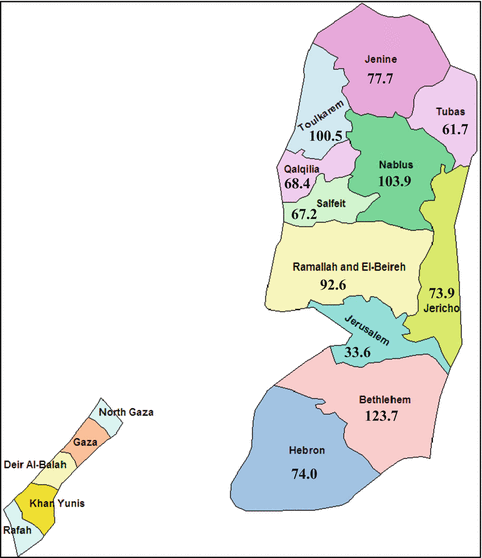

Fig. 6.2
Incidence rates of cancer (per 100,000) in the West Bank governorates in 2013. Source: Data extracted from the Ministry of Health Report, Palestine, 2013
Figure 6.3 shows the increase in cancer incidence rates with increasing age among both males and females as people in age groups of 50 years and older had much higher risk of cancer compared to the age group of less than 50 years [5].
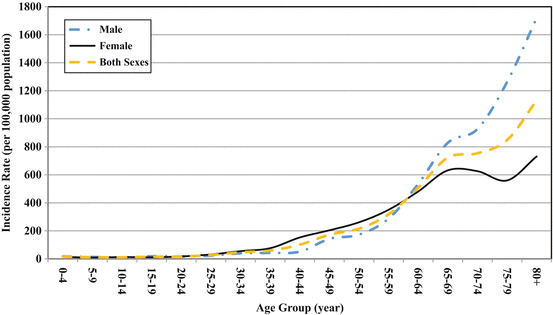

Fig. 6.3
Distribution of incidence rates by age for both sexes, males and females, West Bank, Palestine, 2013. Source: Data extracted from the Ministry of Health Report, Palestine, 2013
Furthermore, the available data from the Ministry of Health reports showed high but fluctuating incidence rates between 2000 and 2011 (Fig. 6.4) but a sharper increase in the trend was observed after 2011. This increase was noticed among both genders and in most regions.
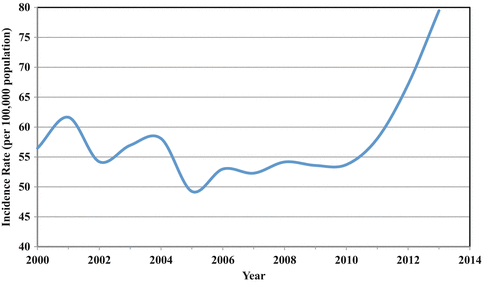

Fig. 6.4
Cancer incidence rates (per 100,000), West Bank, Palestine, 2000–2013. Source: Data extracted from Ministry of Health Reports, Palestine, 2009–2013
Lung cancer is reported to be the most commonly diagnosed cancer among men with an incidence rate of 13.2 cases per 100,000 men, followed by colon cancer (8.9), leukemia (5.8), bladder cancer (5.6) and brain cancer (4.9). Breast cancer is the most commonly diagnosed cancer among women with an incidence rate of 29.4 cases per 100,000 women, followed by colon cancer (8.3), leukemia (4.0), brain cancer (3.4) and thyroid cancer (3.3). Among children less than 15 years old, leukemia is the most common cancer with an incidence rate of 2.6 cases per 100,000 children, followed by brain and nervous system cancers (1.3) and then bone cancer (0.6) (Fig. 6.5) [5].
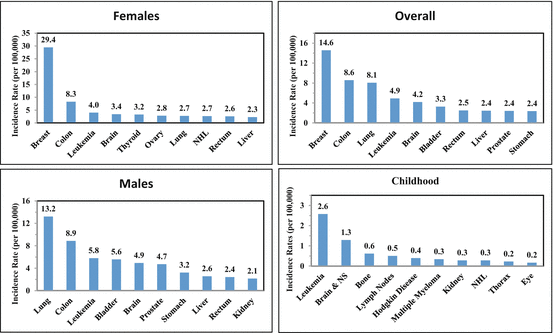

Fig. 6.5
Top ten cancers in the West Bank, Palestine, in 2013. Source: Data extracted from the Ministry of Health Report, Palestine, 2013
A total of 6879 deaths were recorded in the death registry in the West Bank in 2013 with cancer mortality accounted for 13.3 % of total deaths. Cancer mortality pattern in the West Bank showed a slight decrease between 2000 and 2006 then a slight increase with fluctuations between 2006 and 2013 (Fig. 6.6). Lung cancer was the most common cause of cancer deaths (17.9 % from total cancer deaths) in 2013, followed by colon cancer (15.2 %) and then breast cancer (9.1 %) (Fig. 6.7) with cancer related mortality reported mostly in the northern regions of the West Bank followed by the southern and then the middle regions [5].
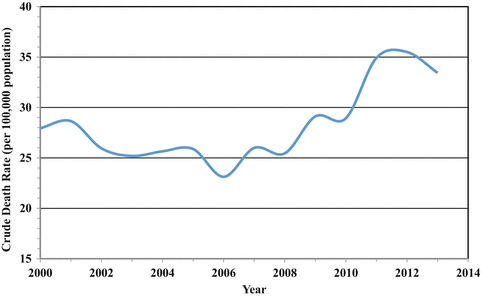
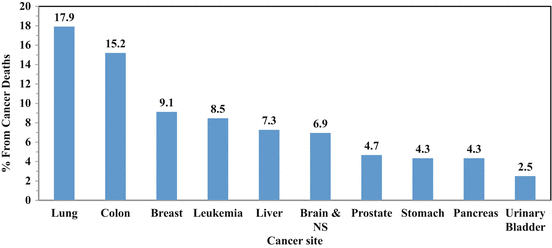

Fig. 6.6
Cancer crude death rates (per 100,000), West Bank, Palestine, 2000–2013. Source: Data extracted from the Ministry of Health Reports, Palestine

Fig. 6.7
Cancer mortality by site (top ten) in the West Bank, Palestine, in 2013. Source: Data extracted from the Ministry of Health Report, Palestine, 2013
Regarding Gaza little data is available on cancer. In a study performed by Yehia Abed about the incidence of cancer in Gaza between 1998 and 2008 which was based on data from the cancer registry in Gaza, it was shown that a total of 7412 cancer cases were reported with 48 % of them were males and 52 % were females with an average incidence rate of 49.2 cases per 100,000. Gaza governorate reported the highest incidence rate (67 cases per 100,000) during the period from 1998 till 2008. Breast cancer was the most diagnosed cancer in Gaza with an incidence rate of 7.8 cases per 100,000, followed by colorectal cancer (4.7), leukemia (4.1), and lung cancer (3.7). Lung cancer was the most common cancer among males with an incidence rate of 5.8 case per 100,000 men, followed by colorectal (4.6), leukemia (4.5) and prostate and bladder cancers. In females, breast cancer had an incidence rate of 15.6 cases per 100,000 females and ranked the first most common cancer among them, the second most common cancer among females was colorectal cancer (4.8), then leukemia (3.8) and thyroid (2.6). Among children younger than 15 years, leukemia was the first most common cancer comprising 30.3 % from all childhood cancers between 1998 and 2008, followed by lymphomas (19.4), and brain and spinal neoplasms (13.9) (Fig. 6.8). Similar to the West Bank, cancer was the second leading cause of death in Gaza with mortality rate of 36.5 per 100,000, comprising 11.8 % of total deaths, with lung cancer being the most common cause of cancer deaths followed by breast cancer and colon cancer [1].
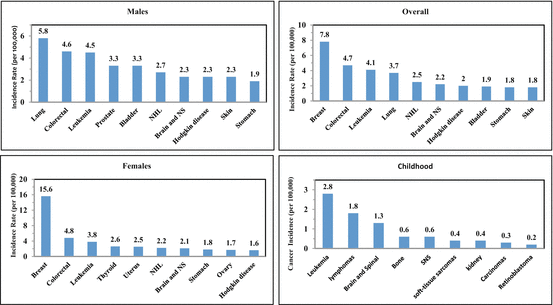

Fig. 6.8
Top ten cancers in the Gaza, Palestine, between 1998 and 2008. Source: Data extracted from Abed, Y. (2014), personal communication. NHL Non-Hodgkin Lymphoma, SNS Sympathetic Nervous System, NS Nervous System
Current Status of Cancer Care
The Palestinians are facing a cancer crisis represented by the noticed increase in cancer incidence and its contribution to the mortality as now it is considered to be the second leading cause of death. Despite that, poor medical facilities, shortage of medicines and primitive approaches that are far away from the currently used advanced multimodality diagnostics and therapeutics are the features of cancer care in this region. In addition, radiation therapy, which is a crucial therapy in cancer treatment, is completely unavailable in the West Bank and Gaza except for the radiotherapy provided by Augusta Victoria Hospital in East Jerusalem for the Palestinians referred from the West Bank and Gaza. Adding to this, the insufficient numbers of specialized doctors and other health professionals in all fields related to cancer care and the very limited and ineffective cancer-prevention strategy. Moreover, the majority of Palestinian cancer patients have late stage incurable disease when first diagnosed and further unavailability of palliative care.
Despite the inadequate health care infrastructure and political and economic instability, governmental health insurance is the only one that covers the treatment of cancer in the country in the governmental hospitals or in referring the patients to other hospitals in the neighboring countries. Cancer registry as one of the governmental institutions is also affected despite the achieved progress during the recent years. The lack of accurate population-based data and the weakness of health information systems are the hallmark of cancer registry. Augusta Victoria Hospital (a nonprofit nongovernmental organization, NGO) is considered to be a leading oncology center both in the infrastructure and the advanced technology used compared to other Palestinian hospitals. Unfortunately, at the academic level, universities are not well integrated in the health care system and there are no invested efforts to capacity build the insufficiency in the human resources in the oncology field except for few training workshops in palliative and cancer care that were organized by universities like a workshop on palliative care held in 2014 by Al-Quds University in collaboration with Middle East Cancer Consortium (MECC) for 40 health professionals from the West Bank and Gaza.
Interrelationships Between Cancer Care and Local Culture
Culture is defined as a set of shared and socially transmitted ideas about the world that are passed down from generation to generation. Local culture has both a negative impact leading to late diagnosis and a positive impact of family providing a warm incubator in addition to religion providing serenity for Palestinian cancer patients. The Interaction between culture, religion, and traditions is one reason that might have contributed to the increase in the cancer incidence in the Middle East, leading cancer to be diagnosed at more advanced stages of the disease. In the West Bank and Gaza, 42 % of cancer cases were not caught until they had spread locally (Stage III) and 18 % until they had spread throughout the body (Stage IV). Most cancer types, like other diseases, such as diabetes and hypertension, have no symptoms for years after onset. Screening tests are not common because of the high cost in low-economic countries. Personal medical checkup is not part of the culture of the Palestinians. On the contrary, people are afraid to go to doctors to be diagnosed with a disease and they prefer to stay away as long as symptoms are absent. Even with symptoms, traditional medicine using herbs and other traditional prescriptions are preferred. Many breast cancer women and colon cancer in men and women can be easily detected at early stages by simple testing like mammography and colonoscopy, respectively. However, these tests are rarely done by undiagnosed Palestinian women and men. So culture is the most significant factor that influences individuals not to seek cancer diagnosis and treatment. The lack of knowledge about cancer also contributed to diagnosing cancer at more advanced stages.
The impact of culture on the individual and on the family is one of great resistance to being diagnosed with cancer. In some Palestinian families, a married women is afraid to be diagnosed with cancer because this will have a negative impact on her personal status in the family and may also affect negatively the reputation of her children especially daughters to get married. Therefore, getting involved in screening tests and going to a family doctor are not in the dictionary of most Palestinians. In fact, there are no such “family doctors” in Palestinian culture.
The family is considered as a significant social organization system in the Palestinian culture. Families in the Palestinian culture are very supportive for their members. Support comes also from the extended family, friends, and neighbors. Regardless of the age of the patient, old people, sick or healthy, stay with the family structure which has a great psychological comfort and is reflected on the healing process of the patient. Families in general have great fear of cancer and cancer is not looked at like other diseases. Cancer is known to be a stigma and most people call cancer “that disease” and are afraid to say “cancer” which inflicts a great psychological stress from the disease and this is reflected on the extra care that cancer patients get from the family and the community in general.
Religious beliefs play an important role at the level of the patient and health care. Islam and Christianity are the primary religions in the West Bank and Gaza. Most patients, like the community in general, have faith in Allah (GOD) which is reflected on how they perceive sickness. Religion imparts more perseverance on cancer patients because of the belief that a person is rewarded in the hereafter and on this life for his/her tolerance to pain and disease. Families and people in general also believe that they are rewarded for taking care of sick people. On the other hand, one study in Gaza revealed that religion and culture were not a barrier to conduct mammography, however, limited resources, lack of awareness and of access to medical facilities were identified as the major barriers.
Many people have little experience with cancer patients and they don’t know what to say to them or how to act. This can be difficult especially when the patient is part of a married couple. The disease often changes hopes and dreams that the couple shares, so, some of their friends or family members may not be able to offer the support that the patient expects.
The Palestinian society sympathizes greatly with cancer patients, and it provides psychological support for them by means of care and giving them strength to face the disease and cope with it. For this we note that friends and relatives visit them frequently because they think that they will not live for a long time, and that they should support and help them as much as they can.
Many families do not like the fact that their ill relatives and loved ones stay at the hospital, especially in the last stages of their disease and they consider it disrespectful, so they are more accepting of home care, this is reflected positively on the cancer patients and families and friends provide some type of support groups.
Individualized Oncology in Focus
In a recent review by Kalia [6], the importance of personalized oncology has been discussed, shedding the light on the importance of genomic analysis, targeted drugs, cancer therapeutics and molecular diagnostics on personalized medicine. The use of biomarkers is the essence of individualized oncology which has already proven to result in more effective treatment protocols. The review highlighted the definition of personalized medicine by the US President’s Council of Advisors on Science and Technology as referring to “…the tailoring of medical treatment to the individual characteristics of each patient; to classify individuals into subpopulations that differ in their susceptibility to a particular disease or their response to a specific treatment so that preventive or therapeutic interventions can then be concentrated on those who will benefit, sparing expense and side effects for those who will not.” To this definition, the Personalized Medicine Coalition has added, “…the molecular methods that make personalized medicine possible include testing for variations in genes, gene expression, proteins, and metabolites, as well as new treatments that target molecular mechanisms. Test results are correlated with clinical factors—such as disease state, prediction of future disease states, drug response, and treatment prognosis—to help physicians individualize treatment for each patient.”
The use of personalized medicine assays requires coordination between a highly qualified team of molecular biologists and clinical staff. In the West Bank, Augusta Victoria is the only hospital that offers individualized oncology genomic-based treatment but it is still limited to certain molecular testing. In breast cancer genetic testing for some genes particularly BRCA (breast cancer) 1 and 2, guides preventive and treatment strategies based on susceptibility risk for breast and ovarian cancers. This screening is performed as part of research collaboration between Augusta Victoria Hospital and Bethlehem University. Colon cancer therapy selection is assessed by genetic assays of KRAS (v-Ki-ras2 Kirsten rat sarcoma viral oncogene homolog) and EGFR (Epidermal growth factor receptor) which are used to check for response to tyrosine kinase inhibitors (TKI) and consequently to provide information for the selection of various therapies. In leukemias and lymphomas individualized medicine also plays a role in Augusta Victoria. In chronic myeloid leukemia or acute lymphoblastic leukemia, Philadelphia chromosome is detected through the quantification of the BCR/ABL (breakpoint cluster region/c-abl oncogene 1, non-receptor tyrosine kinase) and is used to indicate certain therapies like with Imatinib for patients with BCR/ABL and the disease should be followed up by serial quantitative measures of the BCR/ABL. In promyelocytic leukemia which is characterized by the presence of t (15;17) translocation, molecular detection of PML/RARA is used to indicate arsenic trioxide and tretinoin for patients for induction of remission and consolidation. FMS-like tyrosine kinase-3 (FLT3) is used for acute myeloid leukemia treatment. CD20 expression is used to indicate rituximab for the treatment of patients with non-Hodgkin lymphoma. There are several genes involved in the selection of the most appropriate therapies for lung cancer in Augusta Victoria Hospital including EGFR, RRM1 (ribonucleotide reductase M1), and KRAS in addition to several other tests that are used for therapy guidance of different types of cancer.
Stay updated, free articles. Join our Telegram channel

Full access? Get Clinical Tree





